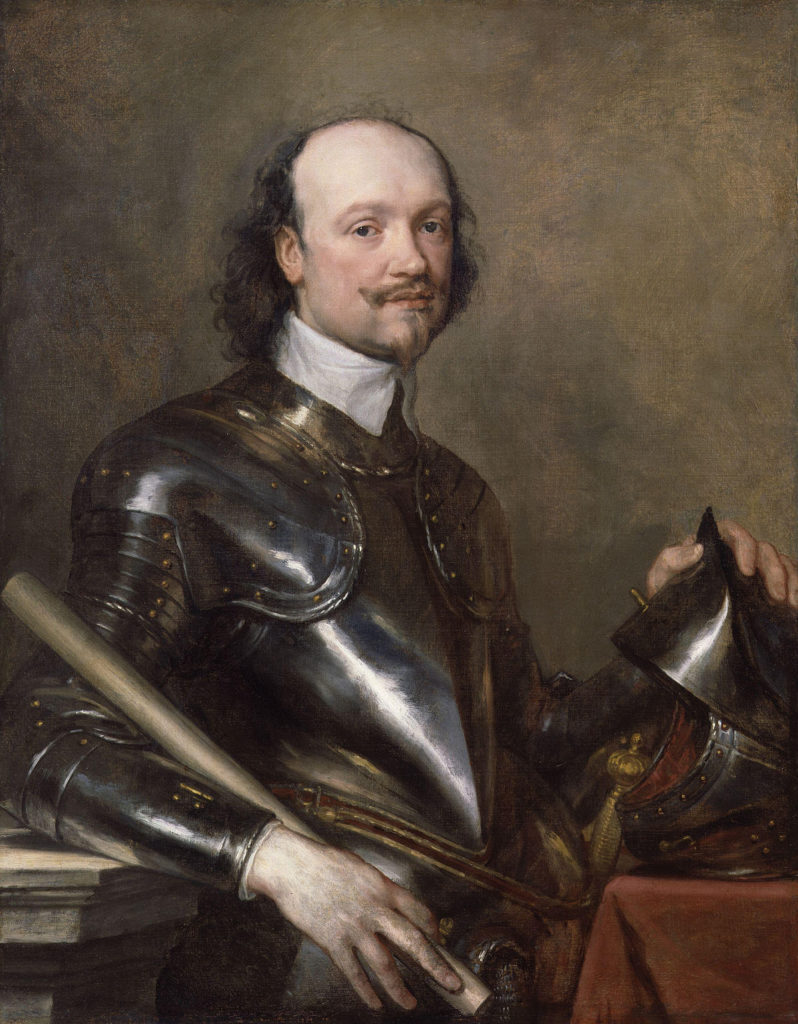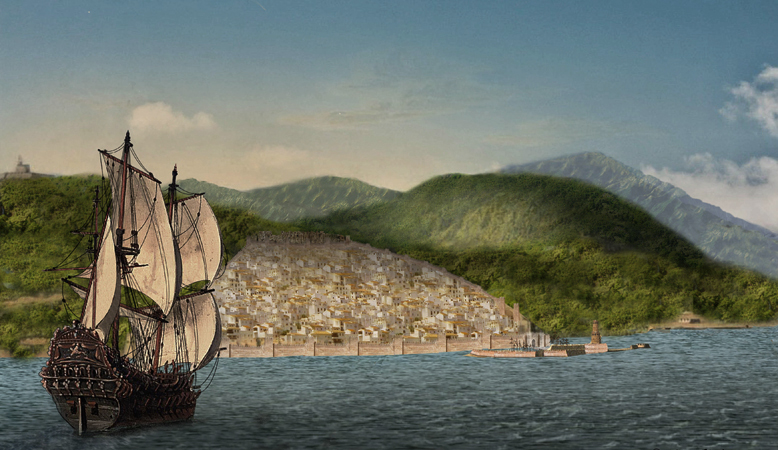Sir Kenelm Digby—an English nobleman of the early seventeenth century—led a complicated life.
His father, Sir Everard Digby, had been one of the conspirators in the (in)famous Gunpowder Plot, which was the attempt—on November 5, 1605—by a group of Catholics to blow up the English parliament buildings (along with the parliamentarians and King James I who were inside the buildings at the time).
In the early seventeenth century, England was a newly Protestant country in which Catholics found themselves to be persecuted second-class citizens. The Catholic conspirators were desperate to change all that.
The plot, however, failed.
The conspirators were rounded up, tortured, and executed. They received the traditional English punishment for treason and were drawn and quartered. That is, they were tethered to a horse and dragged (drawn) to the gallows where they were hanged. Then their hands and feet were tied to four separate horses and the horses driven in different directions, tearing their bodies apart (quartering them).
As the son of one of these executed traitors, Kenelm Digby was born under a cloud. To complicate things further, his mother, a staunch Catholic, reared him as a Catholic. This double stain put him at a serious disadvantage in the robustly Protestant England of the time.
But he came from a wealthy, noble family, and that helped balance the scales.
As the scion of a noble house (even one stained with Catholicism) he naturally attended Oxford when he reached the age for it. He did not graduate, though. His mother packed him off to Europe to keep him away from a young woman he was enamored of and of whom she strongly disapproved.
So young Digby (he was just twenty years old at this point) found himself in Madrid.
As chance would have it, Prince Charles (the English King Charles I to be) showed up in Madrid at the same time (he was on an unsuccessful matchmaking mission to the Spanish court). Digby ended up joining the Prince’s household. The Prince was twenty-three, and the two young men bonded.
This went a long way to rehabilitate Digby.
He returned to England with the Prince, where King James I knighted him and appointed him a Gentleman of the Privy Chamber to Prince Charles.
This new appointment allowed Digby to brave his mother’s disapproval and marry the woman he had been enamored of—though it was a secret marriage that was not revealed for some years.
At this point, Digby had pretty much restored his own and his family’s reputation. He had a young man’s vaulting desire to prove himself to the world, though. He wanted to do great deeds.
Like many young men of the time, when he wanted to do something dashing, dangerous (and remunerative), he turned to privateering.
So he organized a small privateer fleet and, on December 22, 1627, set sail for the Mediterranean.

By February, sickness had struck and many of his crew were dying. Here is his description of it:
“Hourly, my men sickened more and more of an infectious disease that took them with great pain in the head, stomach, and kidneys, putrefying the whole mass of the blood and caused much vomiting, yet they died not suddenly of it, but lingered on with pain and extreme weakness.”
Desperate for a place to drop anchor, clean and disinfect his ships, and allow his remaining men to recover both their health and their spirits, Digby looked around for a port… and settled on Algiers.
This may seem an odd choice at first. After all, Algiers (that ‘nest of pirates’ as it was commonly known to Europeans of the time) was the home base of a large fleet of corsairs who preyed upon European ships—including English ships.
The English, however, had negotiated a treaty with Algiers in 1622. The Algerines took this treaty seriously enough that they sent a Chiaus (an Ambassador) from Algiers to England in 1625. A week after King Charles I’s coronation, this Chiaus presented the new English King with a goodwill gift of Barbary horses, tigers, and lions.
There were serious problems with the observance of this treaty (on both sides), but it still remained nominally in effect. And so Digby decided to take the risk and sail into the Algiers harbor.
Algiers had a reputation as a wild pirate capital—a reputation that was well deserved. But it was nonetheless a functioning city state. As such, it was a political entity, and politics was as important to the city’s survival as piracy.
Digby’s narrative illustrates the politics of Algiers, as well as the complexity of the relations between Algiers and European countries.
Here is Digby’s description of his time in Algiers.
On the 15th day of February, by break of day, we perceive ourselves to be within 5 leagues of the point of Algiers, to which we bore, making very little sail. I had been separated from my Vice Admiral and Captain Michel [other ships/commanders in Digby’s fleet] in a storm the night before. By about noon, we were come to an anchor a little eastward of the mole end, and then I saluted the castle with nine pieces of ordinance.
Before we came in, the wind scanted much upon us, so that we had much ado to round the point, and then the violence of the storm caused us to be in much danger. But my Vice Admiral that came in the next day was in far greater danger, for, mistaking the place, they had embayed themselves in a rocky bay, and if the wind had not suddenly enlarged, they would have run the risk of being cast away. The Patience [one of the ships in Digby’s fleet] came in four hours after me. If I had stayed out 48 hours longer, I would not have had men enough to sail my ship.
I sent that day to the Pasha [the Ottoman Governor of Algiers] to have a safe conduct to come ashore, but it was deferred till the next day, when the Duana [the Divan, the governing council of Algiers] was to meet. But then there was so much combustion among themselves about the displacing the Agha, the principal officer next to the Pasha, [the Agha was the head of both the Algerine janissaries and the Divan] that my business could not be treated of.
On the 17th, they sent me two safe conducts, one from the Pasha, the other from the Duana, and I came that night ashore to the English Consul’s house, Mr. Friswell.
On the 18th, I went to the Pasha, who treated me with much courtesy. I told him that, upon confidence of the safe conducted which the Consul had sent into England from him to serve for security to our nation, I was come thither, and that my example, if I received good usage, would bring many other English thither, and be the cause of a closer correspondence in the future between our two nations.
He assured me of all friendship and told me he hoped the King of England would redress some injuries done to subjects of his state by some of ours. I answered him that my master the King would not fail of doing exact justice whensoever complaint should be made to his Majesty and the offenders be found out. In the meantime, I deemed it a great injustice for them to satisfy private wrongs by taking the goods and substance of English merchants.
At this, the Pasha promised that all former errors should be redressed, and the capitulations [the details of the treaty between England and Algiers] punctually observed.
For more of Sir Kenelm Digby’s narrative, see the next post here in this blog.
__________
For those who may be interested…
Sir Kenelm Digby’s narrative comes from Journal of a Voyage into the Mediterranean by Sir Kenelm Digby, A.D. 1628, edited by John Bruce, published in 1868. The excerpt describing the disease that burned through Digby’s crews is from page 12. The description of Digby’s arrival in Algiers is from pages 15 & 16. I have modernized both the spelling and vocabulary of the original text to make it more accessible.
 The Travels of Reverend Ólafur Egilsson
The Travels of Reverend Ólafur Egilsson
The story of the Barbary corsair raid on Iceland in 1627
Amazon listing